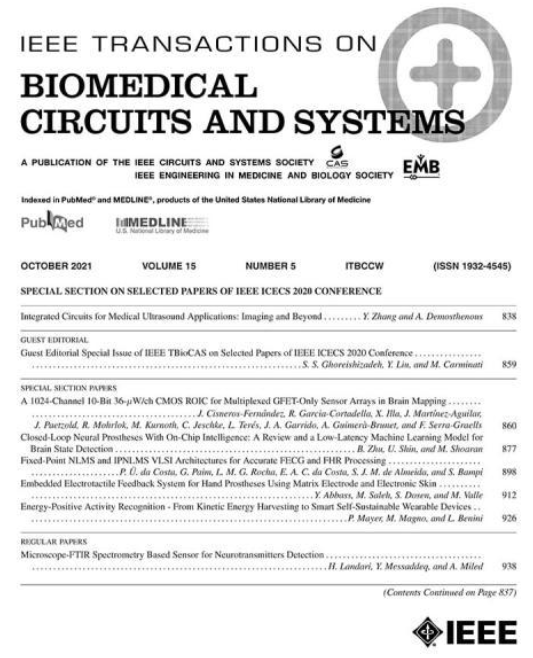用于智能植入式晶体的昼夜节律和心脏眼内压传感器
IF 4.9
2区 医学
Q2 ENGINEERING, BIOMEDICAL
IEEE Transactions on Biomedical Circuits and Systems
Pub Date : 2015-12-01
DOI:10.1109/TBCAS.2015.2501320
引用次数: 34
摘要
本文介绍了一种高精度(0.036毫巴)测量眼压(IOP)的新型青光眼监测系统。该系统不仅可以监测IOP(昼夜IOP)的日常变化,还可以对心跳(心脏IOP)产生的压力信号进行频谱分析。该系统包括一个压阻式压力传感器、一个用于读取传感器数据的专用集成电路(ASIC)和一个安装在定制眼镜上的外部读取器。ASIC读出电子将斩波调制与相关双采样(CDS)相结合,以消除采样频率上的放大器偏移和斩波纹波。此外,可编程电流源用于补偿大气压力(800-1200毫巴)和昼夜节律分量(±7毫巴),从而允许以0.036毫巴的最大精度读出非常微弱的心脏信号(±1.6毫巴)。本文章由计算机程序翻译,如有差异,请以英文原文为准。
A Circadian and Cardiac Intraocular Pressure Sensor for Smart Implantable Lens
This paper presents a new system to measure the Intraocular Pressure (IOP) with very high accuracy (0.036 mbar) used for monitoring glaucoma. The system not only monitors the daily variation of the IOP (circadian IOP), but also allows to perform an spectral analysis of the pressure signal generated by the heartbeat (cardiac IOP). The system comprises a piezoresistive pressure sensor, an application-specific integrated circuit (ASIC) to read out the sensor data and an external reader installed on customized glasses. The ASIC readout electronics combines chopping modulation with correlated double sampling (CDS) in order to eliminate both the amplifier offset and the chopper ripple at the sampling frequency. In addition, programmable current sources are used to compensate for the atmospheric pressure ( 800-1200 mbar ) and the circadian component ( ±7 mbar) thus allowing to read out the very weak cardiac signals ( ±1.6 mbar) with a maximum accuracy of 0.036 mbar.
求助全文
通过发布文献求助,成功后即可免费获取论文全文。
去求助
来源期刊

IEEE Transactions on Biomedical Circuits and Systems
工程技术-工程:电子与电气
CiteScore
10.00
自引率
13.70%
发文量
174
审稿时长
3 months
期刊介绍:
The IEEE Transactions on Biomedical Circuits and Systems addresses areas at the crossroads of Circuits and Systems and Life Sciences. The main emphasis is on microelectronic issues in a wide range of applications found in life sciences, physical sciences and engineering. The primary goal of the journal is to bridge the unique scientific and technical activities of the Circuits and Systems Society to a wide variety of related areas such as: • Bioelectronics • Implantable and wearable electronics like cochlear and retinal prosthesis, motor control, etc. • Biotechnology sensor circuits, integrated systems, and networks • Micropower imaging technology • BioMEMS • Lab-on-chip Bio-nanotechnology • Organic Semiconductors • Biomedical Engineering • Genomics and Proteomics • Neuromorphic Engineering • Smart sensors • Low power micro- and nanoelectronics • Mixed-mode system-on-chip • Wireless technology • Gene circuits and molecular circuits • System biology • Brain science and engineering: such as neuro-informatics, neural prosthesis, cognitive engineering, brain computer interface • Healthcare: information technology for biomedical, epidemiology, and other related life science applications. General, theoretical, and application-oriented papers in the abovementioned technical areas with a Circuits and Systems perspective are encouraged to publish in TBioCAS. Of special interest are biomedical-oriented papers with a Circuits and Systems angle.
 求助内容:
求助内容: 应助结果提醒方式:
应助结果提醒方式:


